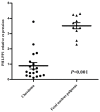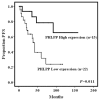Low expression of PHLPP1 in sacral chordoma and its association with poor prognosis
- PMID: 26823799
- PMCID: PMC4713585
Low expression of PHLPP1 in sacral chordoma and its association with poor prognosis
Abstract
Sacral chordoma is a rare spine tumor with a high recurrence rate even after optimal therapy. Previous studies have demonstrated that the PI3K/AKT pathway plays a pivotal role in chordoma, and high expression of pAKT is associated with poor prognosis. Recently, PHLPP was recognized to be a tumor suppressor that targets AKT. We analyzed the expression of PHLPP1 and AKT2 in 37 chordoma samples and 11 fetal nucleus pulposus samples by immunohistochemical staining. Of the chordoma cases, 40.5% (15/37) showed strong cytoplasmic staining (score ≥3) for PHLPP1, which was significantly lower than the 90.9% (10/11) of fetal nucleus pulposus samples (P = 0.004). Conversely, strong immunohistochemical staining for AKT2 was observed in 75.7% (28/37) of chordoma samples, which was significantly higher than 36.4% (4/11) of fetal nucleus pulposus (P = 0.021). Kaplan-Meier survival curves and log-rank test showed that patients with high expression of PHLPP1 experienced longer progression free survival time than those with low PHLPP1 expression (P = 0.011). Further multivariate Cox regression analysis indicated that PHLPP1 expression level and surgical approaches were independent risk factors for chordoma recurrence (P = 0.023 and P = 0.022). However, PHLPP1 expression was not statistically related to patients' total survival time. Conclusively, our results suggest that PHLPP1 plays a crucial role in sacral chordoma, and may be a promising biomarker for prognosis. Meanwhile, manipulation of PHLPP1 expression is also a potential therapeutic approach for the treatment of sacral chordoma.
Keywords: AKT2; PHLPP1; Sacral chordoma; tumor suppressor.
Figures



Similar articles
-
Overexpression of Raf-1 and ERK1/2 in sacral chordoma and association with tumor recurrence.Int J Clin Exp Pathol. 2015 Jan 1;8(1):608-14. eCollection 2015. Int J Clin Exp Pathol. 2015. PMID: 25755752 Free PMC article.
-
What Are the Conditional Survival and Functional Outcomes After Surgical Treatment of 115 Patients With Sacral Chordoma?Clin Orthop Relat Res. 2017 Mar;475(3):620-630. doi: 10.1007/s11999-016-4773-8. Clin Orthop Relat Res. 2017. PMID: 26975382 Free PMC article.
-
Identification of miR-140-3p as a marker associated with poor prognosis in spinal chordoma.Int J Clin Exp Pathol. 2014 Jul 15;7(8):4877-85. eCollection 2014. Int J Clin Exp Pathol. 2014. PMID: 25197358 Free PMC article.
-
Total resection of inferiorly located sacral chordoma with posterior only approach: case report and review of the literature.Turk Neurosurg. 2010 Oct;20(4):527-32. doi: 10.5137/1019-5149.JTN.1776-09.3. Turk Neurosurg. 2010. PMID: 20963705 Review.
-
[Chordoma (a review of 11 cases)].Arch Putti Chir Organi Mov. 1990;38(1):133-46. Arch Putti Chir Organi Mov. 1990. PMID: 2101215 Review. Italian.
Cited by
-
The impact of phosphatases on proliferative and survival signaling in cancer.Cell Mol Life Sci. 2018 Aug;75(15):2695-2718. doi: 10.1007/s00018-018-2826-8. Epub 2018 May 3. Cell Mol Life Sci. 2018. PMID: 29725697 Free PMC article. Review.
-
Prognostic molecular biomarkers in chordomas: A systematic review and identification of clinically usable biomarker panels.Front Oncol. 2022 Sep 29;12:997506. doi: 10.3389/fonc.2022.997506. eCollection 2022. Front Oncol. 2022. PMID: 36248987 Free PMC article.
-
The critical roles of lnc-GLYATL2-2/PD-L1 axis in immune microenvironment and the clinical value of intracranial chordomas.Am J Cancer Res. 2023 Dec 15;13(12):6313-6332. eCollection 2023. Am J Cancer Res. 2023. PMID: 38187065 Free PMC article.
-
Letter to the Editor concerning "Surgical treatment of sacral chordoma: survival and prognostic factors" by C. Ruosi et al. (Eur Spine J; 2015; 24(Suppl 7):S912-S917.Eur Spine J. 2017 Jan;26(1):281-282. doi: 10.1007/s00586-016-4819-3. Epub 2016 Oct 18. Eur Spine J. 2017. PMID: 27757683 No abstract available.
-
Defining preoperative imaging findings of sacral chordomas associated with decreased overall survival and local recurrence.J Spine Surg. 2019 Mar;5(1):171-173. doi: 10.21037/jss.2019.03.04. J Spine Surg. 2019. PMID: 31032452 Free PMC article. No abstract available.
References
-
- Walcott BP, Nahed BV, Mohyeldin A, Coumans JV, Kahle KT, Ferreira MJ. Chordoma: current concepts, management, and future directions. Lancet Oncol. 2012;13:e69–76. - PubMed
-
- Chugh R, Tawbi H, Lucas DR, Biermann JS, Schuetze SM, Baker LH. Chordoma: the nonsarcoma primary bone tumor. Oncologist. 2007;12:1344–50. - PubMed
-
- de Castro CV, Guimaraes G, Aguiar S Jr, Lopes A, Baiocchi G, da Cunha IW, Campos AH, Soares FA, Begnami MD. Tyrosine kinase receptor expression in chordomas: phosphorylated AKT correlates inversely with outcome. Hum Pathol. 2013;44:1747–55. - PubMed
-
- Schwab J, Antonescu C, Boland P, Healey J, Rosenberg A, Nielsen P, Iafrate J, Delaney T, Yoon S, Choy E, Harmon D, Raskin K, Yang C, Mankin H, Springfield D, Hornicek F, Duan Z. Combination of PI3K/mTOR inhibition demonstrates efficacy in human chordoma. Anticancer Res. 2009;29:1867–71. - PubMed
Publication types
MeSH terms
Substances
LinkOut - more resources
Full Text Sources
Miscellaneous
